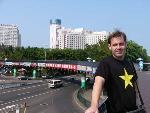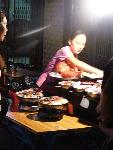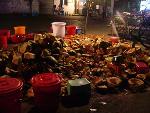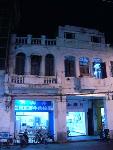- Getting around Lijiang. Dont stay in the Old Towns more than 2 days, there is nothing to do. KRISS Oct 9, 2013 05:46
- 2013 Beijing Temple Fair BENNYLAU Feb 26, 2013 03:29
- Malaysian traveling from KUL - LAX vis Shanghai PVG ZATI_DY Jan 3, 2013 20:15
Hot Days in Haikou
- Views: 11982
- |Vote: 1 0
- |Add to Favorites
- |Recommend to Friends
The New Hongkong City Hotel
I’d just arrived at the wharf of China’s tropical island of Hainan, and as I stood admiring the dockfront architecture – attractive European style new apartment blocks, and a large clocktower overlooking the harbour – I started to consider my first and most basic need – accommodation. I’d spent the evening on a hot boat making the crossing from Guangxi’s port city of Beihai to arrive in Haikou’s new harbour, and as far as I could see, there were zero cheap accommodation options – or hotels at all – within visible distance of the dock.
As I walked towards the gates, I was greeted by the familiar voice of touts offering me taxi rides, tours and cheap hotels – although I’d only recently had a bad experience with a taxi driver taking me to a much too expensive hotel, this time I decided to give them another try. One guy was waving around a brochure for a hotel with a nice swimming pool that he said he could get me into for RMB120 – and offered me an obligation free ride there. Although ‘obligation free’ services always have a catch, the hotel looked nice enough and seemed within my price range, so I stepped on his bus.
It turned out the driver runs a tour agency that is located in the hotel – which was indeed a very nice establishment – and so his motive was to try and convince customers staying at the hotel to take a tour around Hainan. He cheerfully helped me to book the room – at a third of the advertised price – and before long I was sitting in my bright white, spotless temporary abode in Haikou.
Haikou City
Haikou, from my first impressions, seemed far more developed than I had expected. Material I had read about the city described it as a sleepy capital with modern touches – not so, for Haikou is a mighty modern city, all dazzling in white towers and broad, palm-lined streets, bustling with vehicles and business. The harbour complex I had entered was only a fraction of the total, and boats move in and out of the busy port all day loaded with their produce – the trade industry that has made Hainan Island prosperous.
Of course, trade is really only partly responsible for the inherent wealth of the Island, for its tourism revenue is second to none, with both domestic and foreign visitors arriving by the thousands on a daily basis. For many Chinese, Hainan is the premium holiday destination, China’s only genuine tropical paradise and the one place where classically reserved Chinese people can actually let their hair down and have a good time.
Although many head directly for the white sands and rich national resorts at Sanya, there are more than enough reasons to stay a while in the provincial capital of Haikou. Not only does Haikou have its own modest, less visited beaches that are no less stunning, it’s also a place where visitors can enjoy all the conveniences of modern Chinese cities at a generally cheaper price than in the tourist Mecca in the south of the island. Above all, Haikou is warm – in the Winter months, there’s little else you need to know before purchasing your ticket to sunbathe in the unseasonable warm weather.
The City Centre
Haikou seems to have started out as a small congestion of buildings somewhere near the harbour and proceeded to spread out in all directions at once, meaning that it’s difficult to pinpoint an area as the centre of town. However, the New Hongkong City Hotel where I was staying, quite close to Haikou’s wild garden park, is generally located within an area where a good collection of shopping malls and fashion boutiques can be visited.
I got on a bus to the nearby Rainbow Skybridge and had a walk around. Haikou’s heat was incredible, but for a change I really enjoyed the feeling of the hot sunshine, especially as the city had an exceptional number of palm trees everywhere I looked, which really made me feel in my best tropical mood. Even here, vendors were selling fresh coconuts, hacking off the tops with great cleavers and inserting a straw for drinking the milk inside. I have to admit to having a particular passion for coconuts, and happily handed over the extremely cheap price of RMB3 for a chilled whole coconut. The vendor pulled the coconut from a fridge shelf – she had a few lined up next to the cokes – and chopped the lid off for me cheerfully.
Hainanese Cuisine
I was hungry, and looked around for a restaurant close by, eventually settling on a cheap side-street eatery that seemed clean. I browsed their menu for what looked like Hainanese delicacies, but didn’t have much of a clue. The waitress informed me that whilst Hainan is particularly abundant in exotic fruits and vegetables, the most famous dish is a preparation of chicken meat called Wenchang Chicken.
I’d heard of Hainanese Chicken before – it’s famous worldwide – but in Hainan itself it’s referred to as Wenchang Chicken because the dish actually originates from a small town on the north Hainanese coast called Wenchang. Chickens are fatted with rice and peanuts so that the meat is sweet and succulent, and then chopped into small portions and lightly cooked. Those chunks are served as they are – the cuisine’s one major drawback is that the bones still appear bloody – and dip the white chunks in a special ginger sauce.
But the real Hainanese cuisine, she told me, was to be found on the street. I was told that if I headed out towards Haikou’s charismatic old quarter in the early evening, I’d have a chance to see a lot more. With that thought in mind, I decided to head back to my hotel and rest awhile – I was starting to feel the effects of the long, almost sleepless boat ride I’d taken the night before – and then see what I could find in the evening.
Yezi Qingbuliang
Haikou in the evening was warm and welcoming, and as I wandered out of the New Hongkong City hotel into the heat, I was put immediately in that satisfied, casually confident mood that is universally associated with the tropics. I headed over in the direction of the park, where my map told me was a small lake separated into two sections – the East Lake and West Lake – and headed across the causeway in the middle towards Haikou’s Old Quarter. The shimmering reflections of brightly lit apartment buildings shone reflected in the lake waters, and already locals who for reasons of poverty sleep outside were lining the lake edge, stretched out on old cane mats on the footpaths, using their folded sacks as pillows.
Just beyond the lakes was a large public area filled with tables and feasting customers. Just next to it was a large pile of coconut shells, and a couple of hapless young workers sat cross-legged on a large mat cutting them into halves, pouring the milk into tubs, and scraping out the flesh into large bowls. They were preparing the key ingredients for Hainan’s refreshing sweet snack, Coconut Qingbuliang, and I enthusiastically sat to order my bowl.
Qingbuliang is the ultimate answer to a typical sweaty evening in Hainan’s thick tropical heat – a bowl of chilled soft coconut flesh shavings, peanuts, green beans, lentils, red beans, quail egg, dates, tube pasta, jelly pearls, oats, and seaweed. This unlikely mixture, stirred into a cupful of shaved ice and another of sweet coconut juice, is absolutely delicious and as much a meal as a dessert. I looked regretfully at my empty plate, trying to spoon out the last dregs of coconut milk – and at only a few yuan, I couldn’t think of any reason why not to order a second bowl.
The Old Quarter
A little way to the north of the lakes is Haikou’s Old Quarter, a preserve of old buildings dating back to the colonial period. As with many other colonial districts in Southeast Asia, the kinds of buildings to be seen here are old shophouses, an architectural combination of South Chinese and European building styles. I took a couple of turns and was soon in the middle of Zhongshan Lu, where immediately I recognized the strange old edifices, several storied wafer-thin buildings all joined together to form street-long shop faces, decorated with ornate terraces above.
This is an old, busy shopping area and even today it still buzzes with commerce. Merry looking shoppers drifted animatedly between stores, and the air was sweet – the streets seemed to be lined with trees covered in tiny white Jasmine-like flowers that gave off a powerful perfume. I stopped at a little café and ordered a milk tea – which usually taste more like milkshakes than tea – but I was very pleased to receive a cup filled with real coconut juice and very strong actual tea as well as the traditional milk and jelly – the best drink of the kind I’d ever tasted.
The coconut has to be the best and most interesting simple comestible item that exists. I’d read an account of a Vietnamese Buddhist monk who lived only by eating recipes made with coconut – and in Haikou, I began to wonder if he might have been on the right track.









 Copyright © 1998-2025 All rights reserved.
Copyright © 1998-2025 All rights reserved.